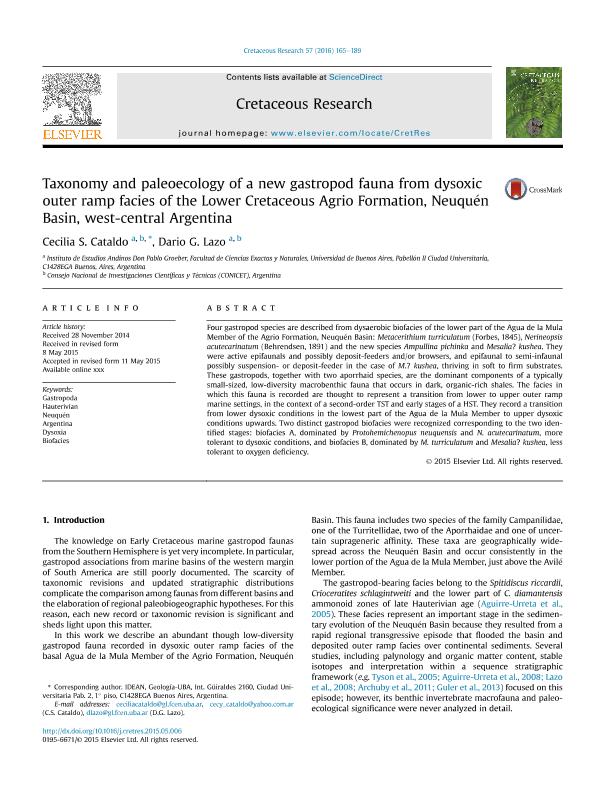Artículo
Taxonomy and paleoecology of a new gastropod fauna from dysoxic outer ramp facies of the Lower Cretaceous Agrio Formation, Neuquén Basin, west-central Argentina
Fecha de publicación:
09/2015
Editorial:
Elsevier
Revista:
Cretaceous Research
ISSN:
0195-6671
Idioma:
Inglés
Tipo de recurso:
Artículo publicado
Clasificación temática:
Resumen
Four gastropod species are described from dysaerobic biofacies of the lower part of the Agua de la Mula Member of the Agrio Formation, Neuquén Basin: Metacerithium turriculatum (Forbes, 1845), Nerineopsis acutecarinatum (Behrendsen, 1891) and the new species Ampullina pichinka and Mesalia? kushea. They were active epifaunals and possibly deposit-feeders and/or browsers, and epifaunal to semi-infaunal possibly suspension- or deposit-feeder in the case of M.? kushea, thriving in soft to firm substrates. These gastropods, together with two aporrhaid species, are the dominant components of a typically small-sized, low-diversity macrobenthic fauna that occurs in dark, organic-rich shales. The facies in which this fauna is recorded are thought to represent a transition from lower to upper outer ramp marine settings, in the context of a second-order TST and early stages of a HST. They record a transition from lower dysoxic conditions in the lowest part of the Agua de la Mula Member to upper dysoxic conditions upwards. Two distinct gastropod biofacies were recognized corresponding to the two identified stages: biofacies A, dominated by Protohemichenopus neuquensis and N. acutecarinatum, more tolerant to dysoxic conditions, and biofacies B, dominated by M. turriculatum and Mesalia? kushea, less tolerant to oxygen deficiency.
Palabras clave:
Gastropoda
,
Hauterivian
,
Dysoxia
,
Paleoecology
Archivos asociados
Licencia
Identificadores
Colecciones
Articulos(IDEAN)
Articulos de INSTITUTO DE ESTUDIOS ANDINOS "DON PABLO GROEBER"
Articulos de INSTITUTO DE ESTUDIOS ANDINOS "DON PABLO GROEBER"
Citación
Cataldo, Cecilia Soledad; Lazo, Dario Gustavo; Taxonomy and paleoecology of a new gastropod fauna from dysoxic outer ramp facies of the Lower Cretaceous Agrio Formation, Neuquén Basin, west-central Argentina; Elsevier; Cretaceous Research; 57; 9-2015; 165-189
Compartir
Altmétricas




